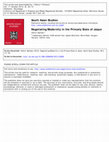Videos by Vibhuti Sachdev
Thoughts on Higher Education
9 views
Papers by Vibhuti Sachdev
South Asian Studies, 2000
... Term Used Aya Aya Vastunara Bandha Yoni Yoni Yoni Aya Aya Aya Grihabandha Yoni Aya Aya buildi... more ... Term Used Aya Aya Vastunara Bandha Yoni Yoni Yoni Aya Aya Aya Grihabandha Yoni Aya Aya building. ... Rajavallabha 111.4-7 House for God, Brahmin's house, water-body, width of house, clothes, Yagya shala (sacrificial Hall), ornaments.Vedi (altar), umbrella. ...
Urban Coding and Planning, ed. Stephen Marshall, Routledge, 2011

This paper questions established accounts of national identity and modernity in Indian art in the... more This paper questions established accounts of national identity and modernity in Indian art in the light of the experience of a princely state. The princely states were regions under indirect British control, ruled by maharajas, nawabs, etc., and their officials. The most prominent role in the story of India's artistic modernity is commonly assigned to the Bengal School, but the implied equation of India with one part of it may be misleading. Throughout the late nineteenth and early twentieth centuries, contrary to the experience of British India, the boundaries of nationhood were already in place for the many princely states, large and small, which numbered well over 500 and together constituted nearly two-fifths of India. In many of these states the chief factor in the fashioning of identity was not nationalism, but modernity. Paradoxically, while the nationalist artists looked ever deeper into India's limitless past to define an Indian identity that stretched beyond current boundaries of time and region, in the princely states Indian-ness was an unselfconscious living reality. My study explores identity and modernity in one political and social context very different from, but concurrent with, the Bengal School – namely the state of Jaipur during the reign of Maharaja Madho Singh II (1880–1922). What were the terms for negotiating modernity and tradition in Jaipur? How was this particular negotiation reflected in the art and architecture patronised by the maharaja, and how did it compare with the contemporary architectural vision in British India? In exploring these questions, the sources used reflect indigenous voices of both British and Indian India.

Jaipur, in Rajasthan, is one of India's most famous cities, and is renowned for its palaces a... more Jaipur, in Rajasthan, is one of India's most famous cities, and is renowned for its palaces and museums, its craft traditions, and its distinctive pink shops and houses. A planned city within walls, it was built in pre-modern times according to a distinctive Indian theory of architecture. As architecture subsequently developed in India, in response to British and latterly post-colonial policies, this system became increasingly marginalized and fragmented, decreasingly practised and understood. Taking Jaipur as a test case, the authors use this lost tradition to explain historic Indian buildings according to the rationale of their original architects. The authors also examine the place of traditional architectural theory in a modern context - post-modern architecture in India has often sought to recapture the spirit of the past, and yet been reluctant to engage with traditional theory. By chronicling the gradual eclipse of Indian architectural theory, the authors explain how this...
South Asian Studies, 2000
... Term Used Aya Aya Vastunara Bandha Yoni Yoni Yoni Aya Aya Aya Grihabandha Yoni Aya Aya buildi... more ... Term Used Aya Aya Vastunara Bandha Yoni Yoni Yoni Aya Aya Aya Grihabandha Yoni Aya Aya building. ... Rajavallabha 111.4-7 House for God, Brahmin's house, water-body, width of house, clothes, Yagya shala (sacrificial Hall), ornaments.Vedi (altar), umbrella. ...

South Asian Studies, 2012
This paper questions established accounts of national identity and modernity in Indian art in the... more This paper questions established accounts of national identity and modernity in Indian art in the light of the experience of a princely state. The princely states were regions under indirect British control, ruled by maharajas, nawabs, etc., and their officials. The most prominent role in the story of India's artistic modernity is commonly assigned to the Bengal School, but the implied equation of India with one part of it may be misleading. Throughout the late nineteenth and early twentieth centuries, contrary to the experience of British India, the boundaries of nationhood were already in place for the many princely states, large and small, which numbered well over 500 and together constituted nearly two-fifths of India. In many of these states the chief factor in the fashioning of identity was not nationalism, but modernity. Paradoxically, while the nationalist artists looked ever deeper into India's limitless past to define an Indian identity that stretched beyond current boundaries of time and region, in the princely states Indian-ness was an unselfconscious living reality. My study explores identity and modernity in one political and social context very different from, but concurrent with, the Bengal School – namely the state of Jaipur during the reign of Maharaja Madho Singh II (1880–1922). What were the terms for negotiating modernity and tradition in Jaipur? How was this particular negotiation reflected in the art and architecture patronised by the maharaja, and how did it compare with the contemporary architectural vision in British India? In exploring these questions, the sources used reflect indigenous voices of both British and Indian India.

Journal of the Royal Asiatic Society, vol.15, 2005
1969 was a time of some introspection for the architectural profession in India. The vision of bo... more 1969 was a time of some introspection for the architectural profession in India. The vision of bold architecture that Nehru had nurtured so personally was now in full bloom. It was, after all, a decade since he had urged architects to break the shackles of tradition in support of Chandigarh – an experiment to embolden the spirit of New India. There was a general sense of relief from professionally trained architects, because for them this political support meant that they could now do what they did best. Not out of choice, but training, they were freed from the burden of addressing tradition, and they could now address foreign design. This was also the time when many were ‘returning home’ after training in European and American schools, and were putting into practice what they had learnt abroad. The ‘foreign-returned’ were the ‘real’ architects who took upon themselves the task of educating their clients, and changing the face of India. They were ‘real’ also because only they had had first-hand experience of what was being taught from books in architecture schools all over India. With scholarship schemes set up by the Nehru government facilitating architects to study in America, it was there that many young architects went to complete their education. Once back they would set their euphoria in concrete and glass. And by 1969 there were already quite a few examples of American-inspired designs in the portfolio of Modern India, and its novelty was beginning to wear off.
South Asian Studies, 2003
... 13, Shesh tola, a pattern of six pieces. ... Plate 5 is a group of carefully drafted drawings... more ... 13, Shesh tola, a pattern of six pieces. ... Plate 5 is a group of carefully drafted drawings of all the panels in Kipling's list, and is entitled "Pinjara or Geometric Lattice Work in Wood, Punjab." These panels are drawn by none other than Ram Singh, who collaborated with Kipling on ...
Page 1. Page 2. Jaipur in Rajasthan is famous for its palaces and museums, its craft traditions a... more Page 1. Page 2. Jaipur in Rajasthan is famous for its palaces and museums, its craft traditions and its characteristic pink shops and houses. A planned city within walls, it was built in prc-modern times according to a distinctive ...
Journal of the Royal Asiatic Society, 2005
Journal of the Royal Asiatic Society, 2005
Medium, 2020
Comparison of education with medication paradigms
Medium, 2020
Mapping recent trends on new mindsets
South Asian Studies, 2000
medium.com , 2020
The essay explores differences in thought processes between mono-cultural and poly-cultural socie... more The essay explores differences in thought processes between mono-cultural and poly-cultural societies and their influences on linear models of learning. Is the outcome driven system of education conducive for customised learning in India?
Conference Paper, 2019
It is not so much about more or less women entering the profession but to see Women in Education ... more It is not so much about more or less women entering the profession but to see Women in Education as a sign of the changes that the disciplines of Architecture and Design are experiencing. The future of these professions is feminine. That is the only way the profession can continue. For this then, we need to examine the process and the nature of these feminising professions.
Uploads
Videos by Vibhuti Sachdev
Papers by Vibhuti Sachdev